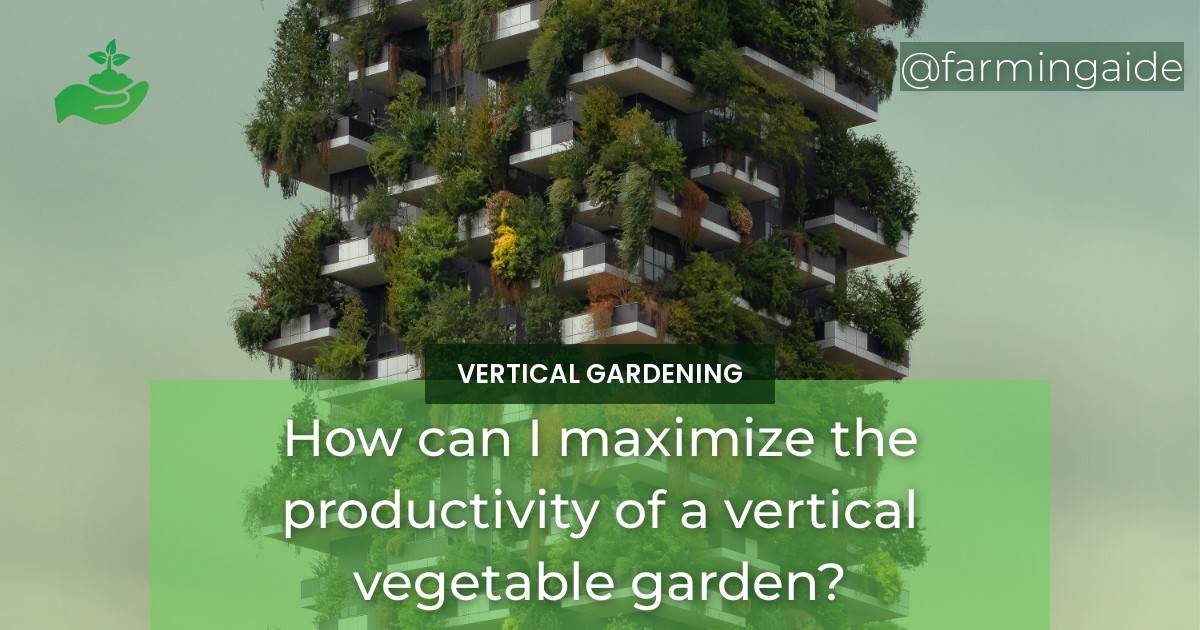If you have limited space, a vertical vegetable garden is a great option to maximize productivity and grow a variety of crops. However, there are specific techniques you should use to ensure the garden thrives and produces an abundance of vegetables. To maximize productivity in a vertical vegetable garden, you should use succession planting, companion planting, and optimize sunlight and nutrient availability. You can also use other techniques like incorporating hydroponics and aeroponics, using pruning and training techniques, and implementing integrated pest management strategies.
Succession Planting in Vertical Gardens
Understanding Succession Planting
Succession planting involves planting crops in stages to ensure a continuous harvest throughout the growing season. In a vertical garden, you can plant new crops as others finish growing or are harvested. This means you can grow more crops in the same space and maximize productivity.
Importance of Succession Planting in Vertical Gardens
Succession planting is essential in a vertical garden because it allows you to take advantage of the limited space and grow more crops. It also helps to extend the growing season and ensures a continuous supply of vegetables throughout the season.
Crops Suitable for Succession Planting in Vertical Gardens
Some crops that are suitable for succession planting in a vertical garden include lettuce, spinach, kale, radishes, and beans. These crops have a short growing season and can be planted in succession to provide a continuous harvest.
How to Succession Plant in Vertical Gardens
To succession plant in a vertical garden, you should:
- Choose crops with a short growing season
- Plant new crops as others finish growing or are harvested
- Ensure proper spacing between plants to prevent overcrowding
- Provide adequate water and nutrients to the plants
Companion Planting Techniques
What is Companion Planting?
Companion planting involves planting different crops together to benefit each other. For example, some plants repel pests, while others attract beneficial insects.
Benefits of Companion Planting in Vertical Gardens
Companion planting helps to improve soil fertility, reduce pests and diseases, and increase yields. In a vertical garden, companion planting can help to maximize productivity and make the most of the limited space.
Companion Planting Techniques for Vertical Gardens
Some companion planting techniques for vertical gardens include:
- Planting herbs and flowers to attract beneficial insects
- Planting beans or peas near corn to provide nitrogen for the corn
- Planting garlic and onions to repel pests
- Planting lettuce and other greens beneath taller crops to provide shade and retain moisture
Common Companion Plants for Vertical Gardens
Some common companion plants for vertical gardens include:
- Marigolds
- Nasturtiums
- Chives
- Basil
- Mint
- Peas
- Beans
ALSO READ
Optimizing Sunlight and Nutrient Availability
Understanding Sunlight and Nutrient Requirements for Vertical Gardens
Plants require sunlight and nutrients to grow and produce vegetables. In a vertical garden, it is essential to understand the sunlight and nutrient requirements of each plant to ensure optimal growth and productivity.
Strategies for Maximizing Sunlight in Vertical Gardens
Some strategies for maximizing sunlight in a vertical garden include:
- Positioning the garden in a location that receives full sun
- Choosing crops that thrive in full sun
- Providing support structures that allow plants to grow vertically and receive maximum sunlight
- Pruning plants to remove dense foliage and improve sunlight penetration
Strategies for Maximizing Nutrient Availability in Vertical Gardens
Some strategies for maximizing nutrient availability in a vertical garden include:
- Using compost or organic fertilizers to enrich the soil
- Choosing crops that have similar nutrient requirements
- Providing adequate water to prevent nutrient leaching
- Using a nutrient-rich growing medium like coco coir or vermiculite
Choosing Suitable Plants for the Available Sunlight and Nutrient Availability
It is essential to choose plants that are suitable for the available sunlight and nutrient availability in your vertical garden. Some crops that thrive in full sun and nutrient-rich soil include tomatoes, peppers, and cucumbers. On the other hand, lettuce and spinach prefer partial shade and nutrient-dense soil.
Which Layout Option for a Raised Bed Vegetable Garden Will Maximize Productivity?
When considering layout options for raised bed vegetable gardens, it’s important to choose a design that will maximize productivity. One effective option is the grid layout, which organizes plants in a tight grid pattern to make the most efficient use of space and sunlight.
Other Productivity-Boosting Techniques for Vertical Gardens
Incorporating Hydroponics and Aeroponics in Vertical Gardens
Hydroponics and aeroponics are soil-free methods of growing plants that can increase productivity in a vertical garden. These methods use water and nutrients to grow plants, which reduces the need for soil and maximizes space utilization.
Using Pruning and Training Techniques for Vertical Garden Plants
Pruning and training techniques can help to maximize space utilization in a vertical garden. These techniques involve removing unnecessary foliage and directing the growth of the plant to maximize productivity.
Implementing Integrated Pest Management Strategies in Vertical Gardens
Integrated pest management involves using a combination of techniques to control pests and diseases in a garden. In a vertical garden, you can use techniques like companion planting, crop rotation, and physical barriers to prevent pests and diseases from damaging your crops.
Proper Maintenance of Vertical Garden Structures and Equipment
Proper maintenance of your vertical garden structures and equipment is essential to ensure productivity and prolong the life of your garden. Regular cleaning and maintenance of equipment like trellises and watering systems can prevent damage and ensure optimal performance.
RELATED ARTICLES:


